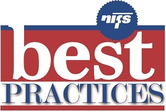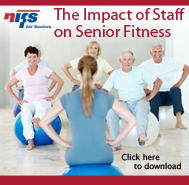 We work on a lot of build/design projects in retirement communities where the project is either new construction for a new community, or the plan is part of a repositioning that includes enhanced wellness spaces and services. If you follow industry trends, you see it all the time in press releases, RSS feeds and other media avenues: ground breakings for projects that include a state-of-the-art wellness wing, indoor/outdoor pool complex, etc. Communities are serious about folding resident wellness into their broader business strategy to remain viable in the market. Over my years at NIFS, I’ve had the pleasure of working on dozens of fitness center builds. As you can imagine, I’ve learned quite a bit along the way. Below are our top five recommendations (in random order) on pitfalls to avoid during your design journey.
We work on a lot of build/design projects in retirement communities where the project is either new construction for a new community, or the plan is part of a repositioning that includes enhanced wellness spaces and services. If you follow industry trends, you see it all the time in press releases, RSS feeds and other media avenues: ground breakings for projects that include a state-of-the-art wellness wing, indoor/outdoor pool complex, etc. Communities are serious about folding resident wellness into their broader business strategy to remain viable in the market. Over my years at NIFS, I’ve had the pleasure of working on dozens of fitness center builds. As you can imagine, I’ve learned quite a bit along the way. Below are our top five recommendations (in random order) on pitfalls to avoid during your design journey.
#5 – Don’t let your design team talk you out of consulting with an expert who is used to programming fitness spaces.
#4 –Don’t overlook the value of qualified management for your fitness areas.
There is nothing worse than pouring money into fabulous state-of-the-art digs than to have them sit idle after the grand opening. We know that senior living fitness centers are not an “if you build it they will come” proposition. Your resident audience will be expecting support to use the pool, fitness center, and other health-related spaces. Plan to hire a qualified manager who is dedicated to running this physical dimension of your wellness strategy. (Note – this is not the same as your fee-for-service personal trainer.) You’ll be glad you did.#3 – Don’t assume that what you’re planning for today will fit you tomorrow.
If you follow #5 and #4 above, you’ll be quite pleased with how well-utilized the exercise programs are in your community. And it won’t be long before you need to add another treadmill, a mat table, or another piece of equipment. If you design with growth in mind, you’ll be able to do some subtle shifting of existing equipment to make new pieces fit. Similarly, if you anticipate that the space and services will quickly become wildly popular, you may need to add staffing. Planning for additional staff workspace is also essential.#2 – Don’t get swept up by a sales pitch from an equipment vendor.
Exercise equipment comes in a lot of shapes and sizes – it is not one size fits all. Treadmills can vary widely on the marketplace in terms of features, cost, warranty, and ease of use. Do your homework (or hire someone to help you) and avoid being swayed by the sales pitches from equipment retailers. All of them will put together a layout for you at “no extra cost”. All of them will tell you they’ve been in the active aging market for decades. All of them will tell you that they have the best science behind their product. It’s a very buyer beware market.#1 – Don’t get tunnel vision on what a quality fitness program (bricks and mortar + management) can do for your residents and the greater community.
Expand your vision of what’s possible in the space. If you can dream big on this project, you’ll be able to anticipate where the market is headed for resident wellness. Do you have an opportunity to capitalize on your local neighbors for some revenue by opening up your fitness center and services to the 55+ community who does not yet live on your campus? Can you see a path to combine therapy and wellness in your new space where the transition of care is seamless for your residents? How do you need to design the space to support these concepts as part of your future? Think about separate entrances, equipment, user privacy needs, data lines and medical records storage. What has to be in place for your dream space to become a reality and potentially a new best practice in resident fitness programming? It can be both exciting and daunting to embark on a substantial construction project. Getting the right stakeholders to the design table early will help you carefully navigate some of the common pitfalls I noted above.NIFS Expertise Makes Our Approach Unique
We have designed dozens of client fitness centers to maximize function and flow in the space with diverse equipment options that meet the needs of active older adults. Check out our case study on how we took the guesswork and the legwork out of a large scale project for a client in Brentwood, Tennessee.
Find out more about NIFS consulting services by clicking below. We can help you bring the best programming, fitness center design and staffing to your community.


 Your marketing and sales team may be missing the mark when selling fitness to residents.
Your marketing and sales team may be missing the mark when selling fitness to residents. Your residents need quality leadership in order to engage in the fitness services.
Your residents need quality leadership in order to engage in the fitness services. From the
From the 


 Make no mistake about it, physical activity is important. Study after study
Make no mistake about it, physical activity is important. Study after study 
 Unless you live under a really, really big rock, you have no doubt heard about the importance of robust wellness opportunities as central to a successful senior living community. There have been some fabulous profiles lately on organizations that are doing an amazing job of connecting their residents and others in the surrounding areas to opportunities to live well. Two recent examples highlighted by
Unless you live under a really, really big rock, you have no doubt heard about the importance of robust wellness opportunities as central to a successful senior living community. There have been some fabulous profiles lately on organizations that are doing an amazing job of connecting their residents and others in the surrounding areas to opportunities to live well. Two recent examples highlighted by  Recruiting residents to participate in your community fitness offerings can be a challenge. Most communities offer a variety of standard services, classes, and programs to try to regularly engage their residents. Whether you are wanting to recruit new residents or spark some enthusiasm for your regulars, read on to learn about three nontraditional programming ideas that can help boost participation in your community fitness offerings.
Recruiting residents to participate in your community fitness offerings can be a challenge. Most communities offer a variety of standard services, classes, and programs to try to regularly engage their residents. Whether you are wanting to recruit new residents or spark some enthusiasm for your regulars, read on to learn about three nontraditional programming ideas that can help boost participation in your community fitness offerings. If you have residents who want to use the fitness center at your community but aren’t sure how to get started safely, you may have given some thought to adding a fitness center manager who can provide that individual attention for your residents. Perhaps you’re unsure about where to start looking for your fitness center manager and what types of things they should be doing while they’re on the job. Read on to learn about four key job responsibilities we think your fitness center manager should be executing often and well.
If you have residents who want to use the fitness center at your community but aren’t sure how to get started safely, you may have given some thought to adding a fitness center manager who can provide that individual attention for your residents. Perhaps you’re unsure about where to start looking for your fitness center manager and what types of things they should be doing while they’re on the job. Read on to learn about four key job responsibilities we think your fitness center manager should be executing often and well.
 NIFS was thrilled to begin fitness management services at two new retirement community client sites in April. Furthermore, we were honored to be able to tailor our staffing services for the unique needs of each location. Community fitness and wellness programs can’t be addressed with a cookie-cutter approach. Read on to learn how NIFS is supporting the unique needs of each location and their residents.
NIFS was thrilled to begin fitness management services at two new retirement community client sites in April. Furthermore, we were honored to be able to tailor our staffing services for the unique needs of each location. Community fitness and wellness programs can’t be addressed with a cookie-cutter approach. Read on to learn how NIFS is supporting the unique needs of each location and their residents.